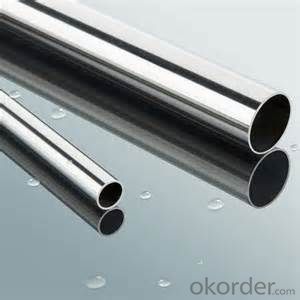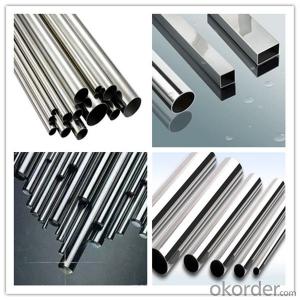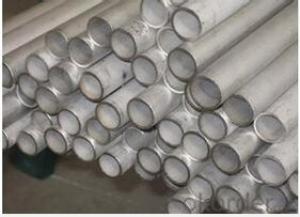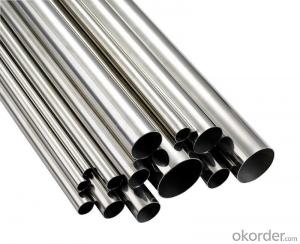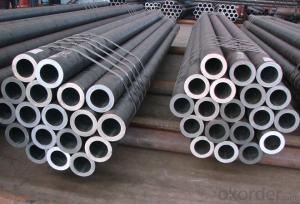Stainless steel pipes 304 pipe
- Loading Port:
- China Main Port
- Payment Terms:
- TT OR LC
- Min Order Qty:
- -
- Supply Capability:
- -
OKorder Service Pledge
OKorder Financial Service
You Might Also Like
In metallurgy, stainless steel, also known as inox steel or inox from French "inoxydable", is a steelalloy with a minimum of 10.5% chromium content by mass.
Stainless steel does not readily corrode, rust or stain with water as ordinary steel does. However, it is not fully stain-proof in low-oxygen, high-salinity, or poor air-circulation environments There are different grades and surface finishes of stainless steel to suit the environment the alloy must endure. Stainless steel is used where both the properties of steel and corrosion resistance are required.
Stainless steel differs from carbon steel by the amount of chromium present. Unprotected carbon steel rusts readily when exposed to air and moisture. This iron oxide film (the rust) is active and accelerates corrosion by forming more iron oxide; and, because of the greater volume of the iron oxide, this tends to flake and fall away. Stainless steels contain sufficient chromium to form a passive film of chromium oxide, which prevents further surface corrosion by blocking oxygen diffusion to the steel surface and blocks corrosion from spreading into the metal's internal structure, and, due to the similar size of the steel and oxide ions, they bond very strongly and remain attached to the surface
High oxidation resistance in air at ambient temperature is normally achieved with additions of a minimum of 13% (by weight) chromium, and up to 26% is used for harsh environmentsThe chromium forms a passivation layer of chromium(III) oxide (Cr2O3) when exposed to oxygen. The layer is too thin to be visible, and the metal remains lustrous and smooth. The layer is impervious to water and air, protecting the metal beneath, and this layer quickly reforms when the surface is scratched. This phenomenon is called passivation and is seen in other metals, such as aluminium and titanium. Corrosion resistance can be adversely affected if the component is used in a non-oxygenated environment, a typical example being underwater keel bolts buried in timber.
When stainless steel parts such as nuts and bolts are forced together, the oxide layer can be scraped off, allowing the parts to weld together. When forcibly disassembled, the welded material may be torn and pitted, an effect known as galling. This destructive galling can be avoided by the use of dissimilar materials for the parts forced together, for example bronze and stainless steel, or even different types of stainless steels (martensitic against austenitic). However, two different alloys electrically connected in a humid environment may act as Voltaic pile and corrode faster. Nitronic alloys made by selective alloying with manganese and nitrogen may have a reduced tendency to gall. Additionally, threaded joints may be lubricated to prevent galling.
Stainless steel is generally highly resistant to attack from acids, but this quality depends on the kind and concentration of the acid, the surrounding temperature, and the type of steel. Type 904 is resistant to sulfuric acid at room temperature, even in high concentrations, type 316 and 317 are resistant below 10% and 304 should not be used at any concentration. All types of stainless steel resist attack from phosphoric acid, 316 and 317 more so than 304; and Types 304L and 430 have been successfully used with nitric acid. Hydrochloric acid will damage any kind of stainless steel, and should be avoided.
The 300 series of stainless steel grades is unaffected by any of the weak bases such as ammonium hydroxide, even in high concentrations and at high temperatures. The same grades of stainless exposed to stronger bases such as sodium hydroxide at high concentrations and high temperatures will likely experience some etching and cracking, especially with solutions containing chlorides.
Types 316 and 317 are both useful for storing and handling acetic acid, especially in solutions where it is combined with formic acid and when aeration is not present (oxygen helps protect stainless steel under such conditions), though 317 provides the greatest level of resistance to corrosion. Type 304 is also commonly used with formic acid though it will tend to discolor the solution. All grades resist damage from aldehydes and amines, though in the latter case grade 316 is preferable to 304; cellulose acetate will damage 304 unless the temperature is kept low. Fats and fatty acids only affect grade 304 at temperatures above 150 °C (302 °F), and grade 316 above 260 °C (500 °F), while 317 is unaffected at all temperatures. Type 316L is required for processing of urea
- Q: What is the difference between hot rolled and cold drawn stainless steel pipes?
- Hot rolled stainless steel pipes are made by heating a steel billet to a high temperature and then rolling it into the desired shape. This process creates a rougher surface and larger dimensions compared to cold drawn stainless steel pipes. On the other hand, cold drawn stainless steel pipes are made by pulling a stainless steel bar through a die at room temperature, resulting in a smoother surface finish and tighter tolerances. Overall, the main difference lies in the manufacturing process and the resulting surface finish and dimensional accuracy of the pipes.
- Q: What are the categories of stainless steel pipes with acid and alkali resistance?
- Stainless steel is usually classified according to the organization of the matrix, as follows:The ferritic stainless steel (200 and 400) the chromium content in 15%~30%, with a body centered cubic crystal structure. This kind of steel does not contain nickel, sometimes also contain a small amount of Mo, Ti, Nb and other elements, this kind of steel has high heat conductivity, low expansion coefficient, good oxidation resistance and anti stress excellent characteristics of stress corrosion, used formanufacturingthecorrosionresistanceofthe atmosphere, water vapor, waterandoxidizing parts. Ferritic stainless steel prices are relatively low and stable, and has many unique characteristics and advantages, it has been proved that in many of the original that can only use austenitic stainless steel (300) application of ferritic stainless steel is a very excellent substitute materials, ferritic stainless steel containing nickel, the main elements of Cr (>10%) and iron, chromium stainless steel special corrosion resistant elements, its price is relatively stable.. Chromium 12% ~ 30%. Its corrosion resistance and toughness increase with the increase of chromium content, and the weldability is excellent.
- Q: Are stainless steel pipes suitable for gas distribution systems?
- Indeed, stainless steel pipes prove themselves to be appropriate for the distribution of gas. Due to its exceptional durability and resistance to corrosion, stainless steel emerges as an excellent choice for transporting gases. Its ability to endure high pressures and temperatures guarantees the safe and effective distribution of gas. Moreover, stainless steel pipes boast a lengthy lifespan, diminishing the necessity for frequent replacements and subsequently reducing maintenance expenses. All in all, stainless steel pipes offer a trustworthy and secure resolution for gas distribution systems.
- Q: Are stainless steel pipes suitable for heat exchangers?
- Stainless steel pipes are appropriate for heat exchangers. Stainless steel possesses remarkable heat resistance properties, making it an optimal choice for applications involving elevated temperatures. It is capable of enduring extreme heat without distorting or compromising its structural integrity. Moreover, stainless steel exhibits a high level of resistance against corrosion, which is vital for heat exchangers as they often come into contact with corrosive fluids or environments. This corrosion resistance guarantees the longevity and dependability of the heat exchanger, minimizing the possibility of leaks or malfunctions. Stainless steel pipes also boast exceptional thermal conductivity, facilitating efficient heat transfer between the fluids within the exchanger. All in all, the durability, corrosion resistance, and ability to withstand high temperatures make stainless steel pipes widely employed in heat exchangers.
- Q: What is the difference between 316 and 316L stainless steel pipes?
- The main difference between 316 and 316L stainless steel pipes lies in their carbon content. Both alloys contain the same amount of chromium, nickel, and molybdenum, which contribute to their corrosion resistance properties. However, 316L stainless steel pipes have a lower carbon content compared to 316 stainless steel pipes. The reduced carbon content in 316L stainless steel pipes helps to minimize the formation of carbide precipitation during welding or high-temperature applications. This process, known as sensitization, can lead to intergranular corrosion, compromising the overall corrosion resistance of the material. By reducing the carbon content, 316L stainless steel pipes are less susceptible to sensitization, making them more suitable for applications where welding is involved. Additionally, the lower carbon content of 316L stainless steel pipes results in improved resistance to corrosion in environments with high chloride exposure, such as coastal areas or industrial settings. This makes 316L stainless steel pipes a preferred choice for various industries, including marine, chemical, and pharmaceutical, where resistance to corrosion is crucial. In summary, while both 316 and 316L stainless steel pipes offer excellent corrosion resistance properties, the lower carbon content of 316L stainless steel pipes provides improved weldability and resistance to sensitization. Therefore, 316L stainless steel pipes are often chosen for applications where welding or exposure to corrosive environments is a concern.
- Q: Can stainless steel pipes be used in the construction industry?
- Indeed, the utilization of stainless steel pipes in the construction industry is feasible. Stainless steel presents numerous advantages, establishing it as a preferred option for diverse construction applications. Initially, the outstanding corrosion resistance of stainless steel pipes is indispensable in construction ventures involving exposure to moisture, chemicals, or severe weather conditions. This resistance against corrosion guarantees the pipes' longevity and durability, subsequently reducing costs associated with maintenance and replacement. Moreover, stainless steel pipes possess remarkable strength and impact resistance, rendering them appropriate for structural purposes in buildings, bridges, and other construction projects. Their strength facilitates the transportation of fluids and gases under high pressure, thus making them ideal for plumbing and HVAC systems. Furthermore, stainless steel pipes demonstrate a high level of hygienic properties and resistance to bacteria growth, which renders them appropriate for implementation in the food and beverage industry, hospitals, and laboratories. These pipes are easily maintained and cleaned, ensuring the safety and purity of the transported materials. Additionally, stainless steel pipes have an aesthetic appeal, as they can be polished to a high shine or finished in various colors, thereby making them suitable for architectural usage. They can be employed for handrails, staircases, exterior cladding, and other decorative components in buildings. In summary, stainless steel pipes are versatile, durable, and corrosion-resistant, which ultimately establishes them as an exceptional choice for the construction industry.
- Q: What is the difference between 17-4PH and 15-5PH stainless steel pipes?
- The main difference between 17-4PH and 15-5PH stainless steel pipes lies in their chemical compositions and mechanical properties. 17-4PH stainless steel contains about 17% chromium, 4% nickel, and 4% copper. It also includes small amounts of molybdenum and niobium. This composition gives it excellent corrosion resistance, high strength, and good toughness. It is commonly used in applications that require high strength, such as aerospace components, oil and gas equipment, and marine applications. On the other hand, 15-5PH stainless steel contains about 15% chromium, 5% nickel, and 3% copper. It also includes small amounts of molybdenum and niobium. This composition provides good corrosion resistance, high strength, and excellent toughness. It is often used in applications that require a combination of strength and corrosion resistance, such as valves, pumps, and shafts. In summary, while both 17-4PH and 15-5PH stainless steel pipes have similar corrosion resistance and high strength, their specific compositions and properties may make them more suitable for different applications.
- Q: Can stainless steel pipes be used for nuclear waste storage?
- Yes, stainless steel pipes can be used for nuclear waste storage. Stainless steel is commonly used in the nuclear industry due to its excellent corrosion resistance and durability. It can effectively contain and store radioactive waste without compromising the safety and integrity of the storage system.
- Q: What's the difference between stainless steel decorative pipes and polished stainless steel pipes?
- Stainless steel decorative tubes are mainly used for decoration, such as railings, staircases, hand guards, railings, windows and so on, the wall thickness is very thin,Polished stainless steel pipe is not the same, the industry can also be used, that is, just made out, some rough, not smooth, so polished under the smooth, according to customer needs.
- Q: Water and electricity thin wall stainless steel tube 304 material delta 2 what does that mean?
- 304 stainless steel is a universal stainless steel material, antirust performance than the 200 series of stainless steel material stronger.
Send your message to us
Stainless steel pipes 304 pipe
- Loading Port:
- China Main Port
- Payment Terms:
- TT OR LC
- Min Order Qty:
- -
- Supply Capability:
- -
OKorder Service Pledge
OKorder Financial Service
Similar products
Hot products
Hot Searches
Related keywords

